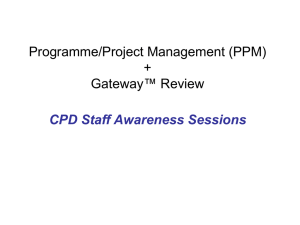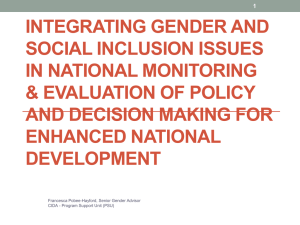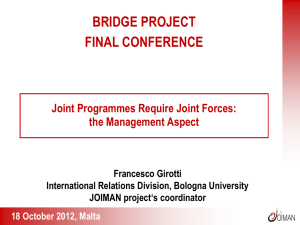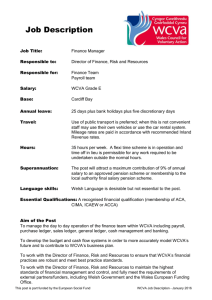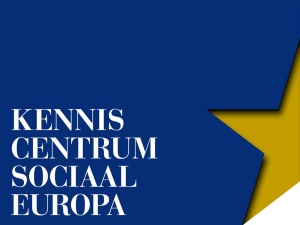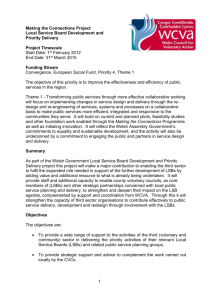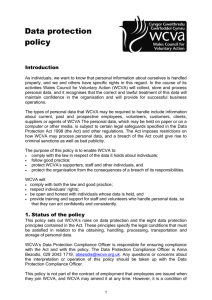Recent WCVA Presentation on Europe 2020
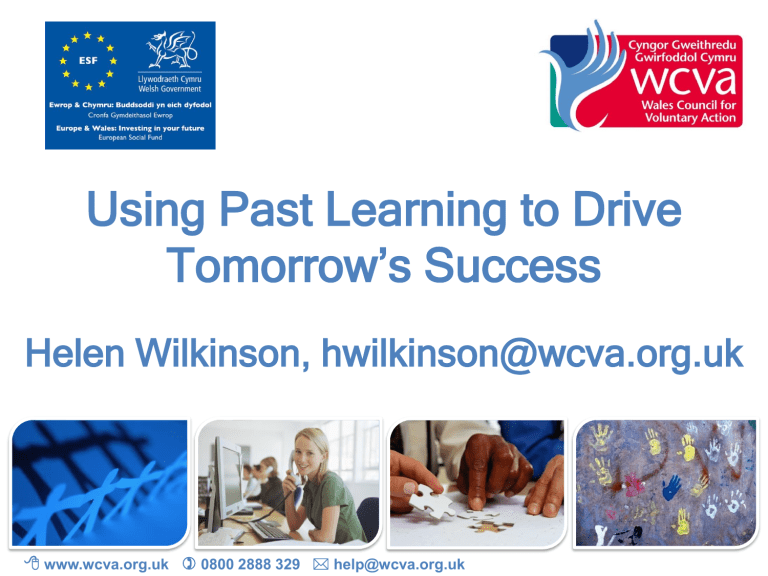
Using Past Learning to Drive
Tomorrow’s Success
Helen Wilkinson, hwilkinson@wcva.org.uk
www.wcva.org.uk
0800 2888 329 help@wcva.org.uk
Policy Drivers to 2020
• Welsh Programme for Government is prioritising jobs and growth & places tackling poverty at heart of agenda alongside sustainable development as central organising principle;
• Anti-poverty plan published in June 2012 – with commitment to annual refresh twelve months on;
• European Commission 2020 goals have prioritised smart, sustainable and inclusive growth & poverty and social inclusion are a key theme and priority of European Structural
Funds 2014-2020;
Key Policy Drivers to 2020 ctd
• WG Regeneration Review Consultation – imminent
• Structural Funds Consultation early in New Year,
2013
• AntiPoverty Action Plan ‘refresh’ June 2013
• Other UK Policy drivers ? – Impact of welfare reform, another Austerity budget, challenging global economic picture ...AND more...
Third Sector Response to 2020 ctd
• Policy drivers provide a focus for coordinating antipoverty action and programmes in Wales;
• WCVA and its Board have prioritised tackling poverty, jobs and Europe as key corporate priorities for WCVA and its work with the sector in 2013-2014;
• The Third Sector Anti Poverty Programme Taskforce emerges from this context and these corporate commitments;
Third Sector Response to Europe
2020
• The sector endorses Europe 2020 goals of smart, sustainable and inclusive growth;
• These goals reinforce the major role the sector should play in delivering play in delivering programmes 2014-2020;
• Sector ethos mirrors Europe 2020 goals
• The sector works smartly - e.g.leveraging volunteer time as match funding;
• The sector promotes sustainability and inclusion – the core business ethos/model (e.g. organisations set up to tackle or meet social need) promote sustainable and inclusive growth (in contrast to private sector ethos which is set up to make profit)
Third Sector Response to Commission’s Draft
Legislative Proposals
The sector welcomes:
• Inclusion of social innovation as a theme within the programmes
– third sector is a key innovator
• 20% of ESF being ring-fenced for promoting social inclusion/combating poverty – resonates with WG Anti-Poverty commitments & Third Sector priorities
• Community-led local development approaches – so long as third sector is equal partner ( also role of community hubs as delivery partners)
Third Sector response to Commission’s
Draft Legislative Proposals ctd ...
We also WELCOME .
..
•
Harmonisation of the rules – making possible multi-fund projects
• More flexible funding mechanisms , in the form of competitive or global grants (as an alternative to procurement)
• Promotion of the increased use of financial instruments such as loan finance – as a way of reducing grant dependency & promoting financial legacy for programmes
Transformation? What
Transformation?...
• The sector welcomes Transformation agenda;
• BUT.
... Concerned that focus is on transformation at the more skilled end, NOT at lower end ;
• Strategies for transformation & innovation need to focus as much on lower skilled as high end IF we are to meet Europe 2020 of smart, sustainable and inclusive growth
Jobs NOT only answer to poverty
• Sector concern a bout over-emphasis on hard employment outcomes rather than client journey;
• Innovative programmes/projects meeting needs of those furthest from the labour market could suffer through this approach;
• Work alone does not provide a route out of poverty JRF stats on in work poverty
• Quality of jobs & work progression = key if we are to tackle poverty
• Need other programmes & innovations – e.g. to develop individual and community resilience/promote routes out of poverty by tackling prices, cost of living, etc through renewable energy, local food coops & food production, etc;
Third Sector Footprint
• Third Sector organisations are key catalysts for
TRANSFORMATION at the lower end of skills and jobs market
• Third sector organisations have become skilled in MOBILISING
AND GENERATING SOCIAL CAPITAL (through volunteering, community regeneration, skills and training programmes, etc)
•
• Third sector organisations have become INCUBATORS &
INNOVATORS for long term transformation and change (of people and places)
Key Messages from Sector
• The third sector = key strategic partner for tackling poverty , developing and delivering innovative anti-poverty services and programmes;
• The sector has a strong track record in delivering a wide range of
ESF, ERDF & RDP funded European programmes and projects;
• The sector is committed to ensuring that opportunities arising from
European Structural Funds are aligned to and maximise
Programme for Government objectives & the role of third sector in delivery ;
Key Messages from the Sector
• Tackling poverty & promoting social inclusion is too important to become part of a tick box exercise in
European programmes;
• The three pillars of SF Programmes for 2014-2020 should be sustainable development, equalities and tackling poverty/promoting social inclusion ;
• This approach needs to be foregrounded, and mainstreamed in European programmes, and embedded through WG departments;
Learning from the Past ...
• Experience of Sector in Previous SF rounds
• Examples of Best & Worst Practice & lessons to be learnt
• Challenges Sector faces in accessing
Structural Funds
Objective One
• Third Sector was actively involved in SF & actively involved in delivery
• Community & local levels were fully engaged
• Multiplicity of projects but potentially too small, and dispersed to achieve large scale impact or strategic footprint
SF 2007-2013 – Current Round
•
Current programme = response to perceived weaknesses of
Objective One - two steps forward, one step back ...
• Emphasis on bigger strategic projects & programmes BUT
....sometimes seen at cost of local and community input
• Some concerns that shift to bigger, more strategic programmes/projects led to over-use of procurement which has caused some problems for third sector;
• Procurement culture can be risk averse, and overly-prescriptive – stifling experimentation and innovation
Challenge for 2014-2020
• How to take one GIANT step forward to Europe 2020 goals – staying stuck OR going in and out of the revolving door is not an option !
• Trick is to apply learning from experience of both rounds
& achieve step shift
• Pragmatic & flexible approach is key
• National & regional delivery models MUST take account of local need
• Encourage active involvement & engagement locally, regionally & nationally – go beyond rhetoric of co-design and co-production, and put it into practice
Challenge for 2014-2020
• Strike the balance between bigger more strategic programmes whilst retaining local delivery & personalisation
• Ensure design & delivery of SF programmes are third sector friendly
• Involve third sector as key strategic partners – design & delivery (as lead partners, as well as part of supply chain)
• Flexible approach = key e.g. grants & procurement – apply learning from the margins of SF Programmes into the mainstream
Worst Practice VS Best Practice
• Procurement has in general been done badly – particularly
?
procurement by public institutions (one result is third sector getting relatively small slice of the funding cake)
• In contrast, the third sector has successfully innovated and managed effective procurement which empowers and enables the third sector & deliver community benefit – e.g. Gateway programme
• Key Opportunity for the future – to apply the learning from the third sector and mainstream this approach more generally
• WG Community benefits procurement approach is an example, and leveraging public sector spend for public good and anti-poverty outcomes - same applies to European SF
The Third Sector – Value Added
• The sector’s experience shows it can strike the balance between bigger more strategic programmes whilst retaining local delivery & personalisation
• WCVA’s Gateway programme – a model of Active Inclusion , third sector friendly procurement & applying competitive grants to deliver improved performanc e
• Third sector innovated to make procurement work for community benefit – Community Benefits procurement approaches now being mainstreamed
Sector Investment Impact
• Over 200 third sector organisations across every part of Wales, many of them local groups with local specialisms, have accessed
European funding through WCVA’s Engagement Gateway and
Intermediate Labour Market (ILM) projects
• Because the third sector can leverage volunteer-time as matchfunding, as well as other forms of matchfunding, the £96.4m ultimately generates a total investment of £176.1m
• Wales is one of Europe’s leaders when it comes to utilising volunteer-time as match-funding, and the only nation in the UK to add value to European funding in this way
Third Sector Impact
• Over £96m of EU funds have been committed to 35 projects led by the third sector under the 2007-2013 programmes - 6% of the total funds available
• Third sector-led projects have supported a total of 76,600 people during current round of structural funds.
• These projects are changing lives
• 18,800 people will achieve qualifications by the end of the programmes; some for the very first time
• 7,100 people will move from unemployment into a job; many from the most challenging circumstances of economic inactivity
• Almost 700 new jobs will be created
How the third sector can collaborate with others to maximise impact
www.wcva.org.uk
0800 2888 329 help@wcva.org.uk
Working at the margins, BEFORE moving into the mainstream
• History of WCVA’s ILM - migrates from Objective One into 2007-
2013 programme ;
• First programme provides proof of concept , independent evaluations provide evidence base & learning applied in 2007-
2013 programme ;
• Gateway programme for those further from the labour market than ILM participants was ‘spun out’ in 2007-2013 as new programme (reaching more people & actively promoting inclusion );
• ILM in 2007-2013 characterised by wide range of localised activities, strong regional networks/delivery structure, excellent model of partnership working & meeting national objectives;
Working at the margins, BEFORE moving into the mainstream ctd ...
• ILM becomes established national strategic programme = built third sector supply chain, promoted collaboration & partnership between national/local government incl public, private & third sector;
• Intermediate Labour Market & Supported Employment approach tested further & applied to specific target groups in
2007-2013 – e.g. NEETs ILM pilot in partnership with WG/WEFO;
• ILM migrated again & mainstreamed into WG’s Jobs Growth
Wales to extent that 25% of JGW is now being delivered by the third sector including a supported employment component ;
Next steps for the third sector
• Be proactive about communicating key messages
• Strengthen channels of dialogue with WG depts/WEFO &
European Commission & other stakeholders;
•
• Start formulating ideas that fit with the strategic direction of the new programmes;
• Continue focus on performance of current projects alongside innovation & ideas generation for 2014-2020;
• Events like today an opportunity to keep the dialogue going with all key stakeholders
Thank you for listening
Helen Wilkinson, hwilkinson@wcva.org.uk
www.wcva.org.uk
0800 2888 329 help@wcva.org.uk


